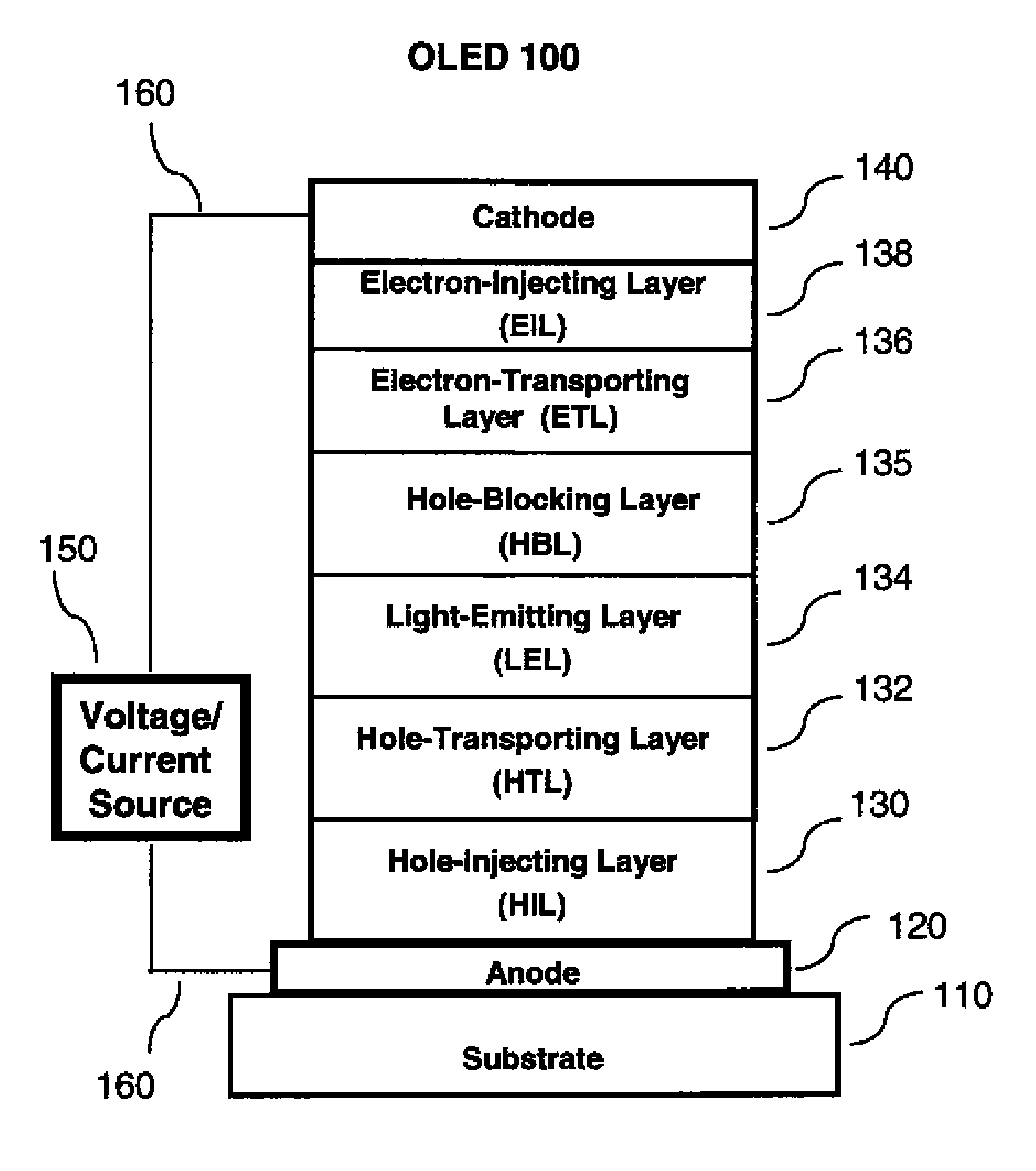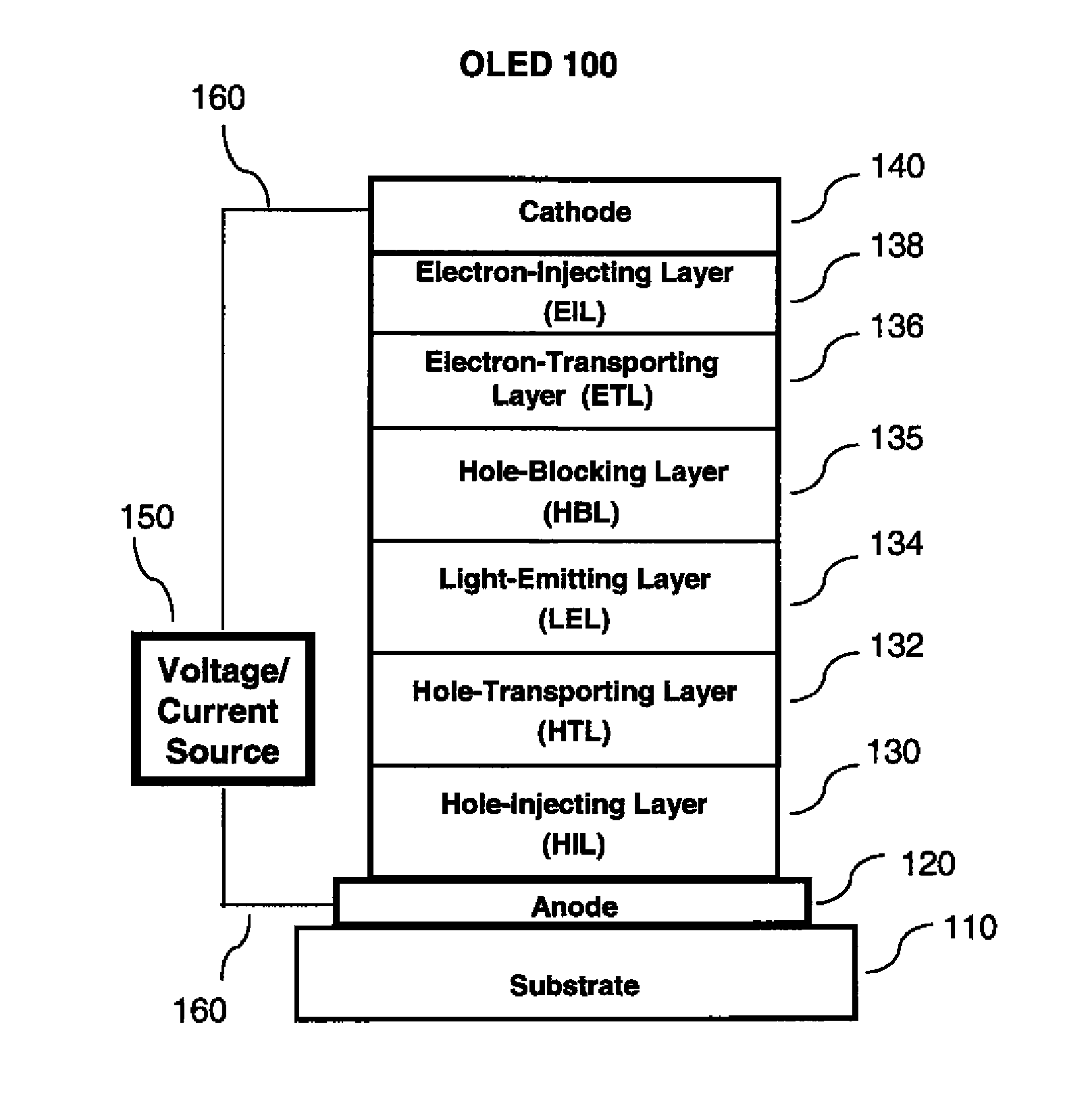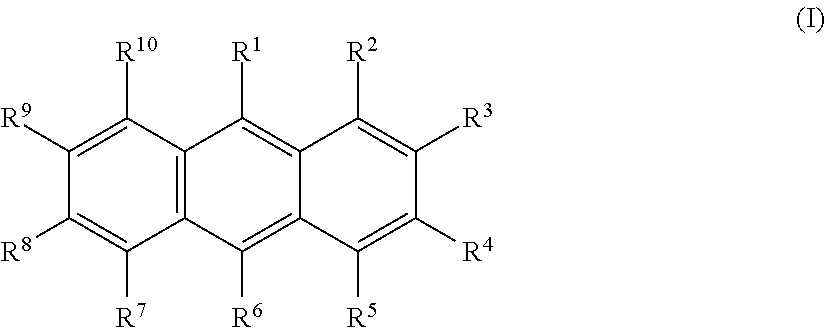OLED with high efficiency blue light-emitting layer
a blue light-emitting layer, high-efficiency technology, applied in the direction of thermoelectric devices, discharge tube luminescnet screens, natural mineral layered products, etc., can solve the problems of reducing the efficiency of the color-complementary layer(s) in the white oled, reducing the efficiency of the color-complementary layer(s) and the blue lifetime, and reducing the efficiency of the blue lifetime. , to achieve the effect of reducing the cost of production,
- Summary
- Abstract
- Description
- Claims
- Application Information
AI Technical Summary
Benefits of technology
Problems solved by technology
Method used
Image
Examples
experimental examples
[0089]The following table lists LUMO values for selected materials used in the following experiments. TPBI is 2,2′,2″-(1,3,5-benzenetriyl)tris[1-phenyl-1H-benzimidazole]. Alq is tris(quinolin-8-olato)aluminum(III). BAlq′ is bis(2-methylquinolin-8-olato)(2,6-diphenyl-phenolato)aluminum(III). CH-1 is bis(9,9′-spirobifluorene-2-yl) ketone.
[0090]
TABLE AExperimentally-determined (column 2) and calculated(column 3) LUMO energies for selected materials.MaterialLUMO expLUMO calcA-1−2.52−2.53A-2−2.44−2.46A-3−2.45−2.45A-4−2.45−2.46A-5−2.40−2.40CBP−1.96−2.13CH-1−2.42−2.50Alq−2.50−2.51N-1−1.95−2.03B-1−1.60B-2 (mCP)−1.78−1.75NPB−1.93−2.06B-3−2.21B-4−2.13−2.13Ir(ppy)3−2.04−2.10Bphen−2.40−2.29TPBI−2.27−2.09BAlq′−2.42−2.50F-1−2.57−2.61
example series 1
[0091]EL devices 1-1 to 1-36 were constructed in the following manner:[0092]1. A glass substrate, coated with an approximately 25 nm layer of indium-tin oxide (ITO) as the anode, was sequentially ultrasonicated in a commercial detergent, rinsed in deionized water, dried and exposed to oxygen plasma for about 1 minute.[0093]2. Over the ITO a 1 nm fluorocarbon (CFx) hole injecting layer (HIL1) was deposited by plasma-assisted deposition of CHF3 as described in U.S. Pat. No. 6,208,075.[0094]3. A 10 nm layer of dipyrazino[2,3-f:2′,3′-h]quinoxaline-2,3,6,7,10,11-hexacarbonitrile (HAT-CN) was then vacuum-deposited as a second hole-injection layer (HIL2).[0095]4. Next, a hole transporting layer (HTL) of N,N′-di-1-naphthyl-N,N′-diphenyl-4,4′-diaminobiphenyl (NPB) was vacuum-deposited to a thickness of 75 nm.[0096]5. A 25 nm light emitting layer including A-4 and 7% S-2 was then vacuum-deposited onto the HTL.[0097]6. A thin first ETL (ETL1) was vacuum-deposited over the LEL with thickness an...
example series 2
[0105]EL devices 2-1 to 2-9 were constructed in the same manner as Example Series 1 except that the material in the LEL was varied according to Table 2. CBP is 4,4′-bis(N-carbazolyl)-1,1′-biphenyl. Devices were aged electrically at room temperature at a constant current density of 80 mA / cm2 (DC mode). The lifetime (T50), or operational stability, of an OLED device is defined as the number of hours required for the luminance at 80 mA / cm2 to drop to half the luminance of the fresh device.
[0106]
TABLE 2ETL1 Variations with Anthracene and Non-AnthraceneLEL Host and Anthracene A-1 in ETL2ETL1LELThicknessT50 at 80ExamplehostETL1(nm)Vcd / AEQEmA / cm21-1A-1NoneNone3.28.36.5165(Comp)1-2A-1N-10.53.18.206.4175(Comp)1-3A-1N-11.53.310.38.0147(Inv)1-4A-1N-12.53.512.29.4111(Inv)1-5A-1N-13.53.710.48.174(Inv)1-6A-1N-15.04.57.76.0102(Comp)1-10A-1mCp1.53.311.98.6162(Inv)1-11A-1mCp2.53.412.49.1168(Inv)1-12A-1mCp3.53.412.69.2125(Inv)2-1CBPNoneNone5.03.52.727(Comp)2-2CBPN-11.54.94.73.424(Comp)2-3CBPN-12.55.2...
PUM
| Property | Measurement | Unit |
|---|---|---|
| thick | aaaaa | aaaaa |
| thick | aaaaa | aaaaa |
| LUMO | aaaaa | aaaaa |
Abstract
Description
Claims
Application Information
 Login to View More
Login to View More - R&D
- Intellectual Property
- Life Sciences
- Materials
- Tech Scout
- Unparalleled Data Quality
- Higher Quality Content
- 60% Fewer Hallucinations
Browse by: Latest US Patents, China's latest patents, Technical Efficacy Thesaurus, Application Domain, Technology Topic, Popular Technical Reports.
© 2025 PatSnap. All rights reserved.Legal|Privacy policy|Modern Slavery Act Transparency Statement|Sitemap|About US| Contact US: help@patsnap.com



